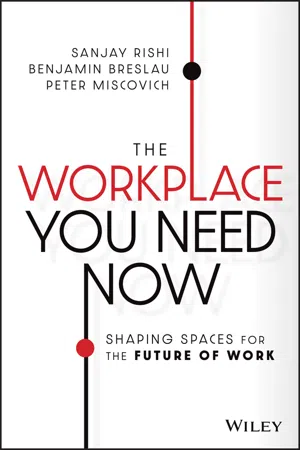
The Workplace You Need Now
Shaping Spaces for the Future of Work
- English
- ePUB (mobile friendly)
- Available on iOS & Android
The Workplace You Need Now
Shaping Spaces for the Future of Work
About this book
Accelerated by the COVID-19 pandemic, the world of work has undergone a lasting transformation. Individuals, organizations and institutions are seeking the right balance of workspace opportunities. Workers want to know how remote work can fit into their lives, and how the office can meet their needs.
In The Workplace You Need Now: Shaping Spaces for the Future of Work, work environment executives and experts Dr. Sanjay Rishi, Benjamin Breslau and Peter Miscovich deliver a practical framework for how to plan, invest in and create effective digital/physical hybrid workplaces that are beginning to define the world of work.
The book explores paths to creating new workplaces that drive the four C's of value: culture, collaboration, creativity, and community. It walks you through the design of custom, flexible, digitally integrated workplaces that manifest new ways of working, and attract tomorrow's top talent. You'll discover the personalized, responsible, and experiential workplace that individuals and organizations alike seek to encourage human interaction, and fuel creativity and growth. You'll learn the path to the purposeful, resilient workplace that incorporates the emerging imperatives of health, wellness and environmental sustainability.
Rich with examples from leading organizations from across the globe, The Workplace You Need Now is an indispensable resource for individuals, as well as businesses of all shapes and sizes trying to find the right solution that works for them right now.
Frequently asked questions
- Essential is ideal for learners and professionals who enjoy exploring a wide range of subjects. Access the Essential Library with 800,000+ trusted titles and best-sellers across business, personal growth, and the humanities. Includes unlimited reading time and Standard Read Aloud voice.
- Complete: Perfect for advanced learners and researchers needing full, unrestricted access. Unlock 1.4M+ books across hundreds of subjects, including academic and specialized titles. The Complete Plan also includes advanced features like Premium Read Aloud and Research Assistant.
Please note we cannot support devices running on iOS 13 and Android 7 or earlier. Learn more about using the app.
Information
PART I
The Personalized Workplace
“My philosophy is that everything starts with a great product.”Steve Jobs, Co-Founder, Apple Inc.

1
The Origin and Evolution of Workplace
“Those who cannot remember the past are condemned to repeat it.”George Santayana, Philosopher
Table of contents
- Cover
- Table of Contents
- Title Page
- Copyright
- Dedication
- Introduction
- Preface
- PART I: The Personalized Workplace
- PART II: The Responsible Workplace
- PART III: The Experiential Workplace
- PART IV: The Path Forward
- Acknowledgments
- About the Authors
- Index
- End User License Agreement